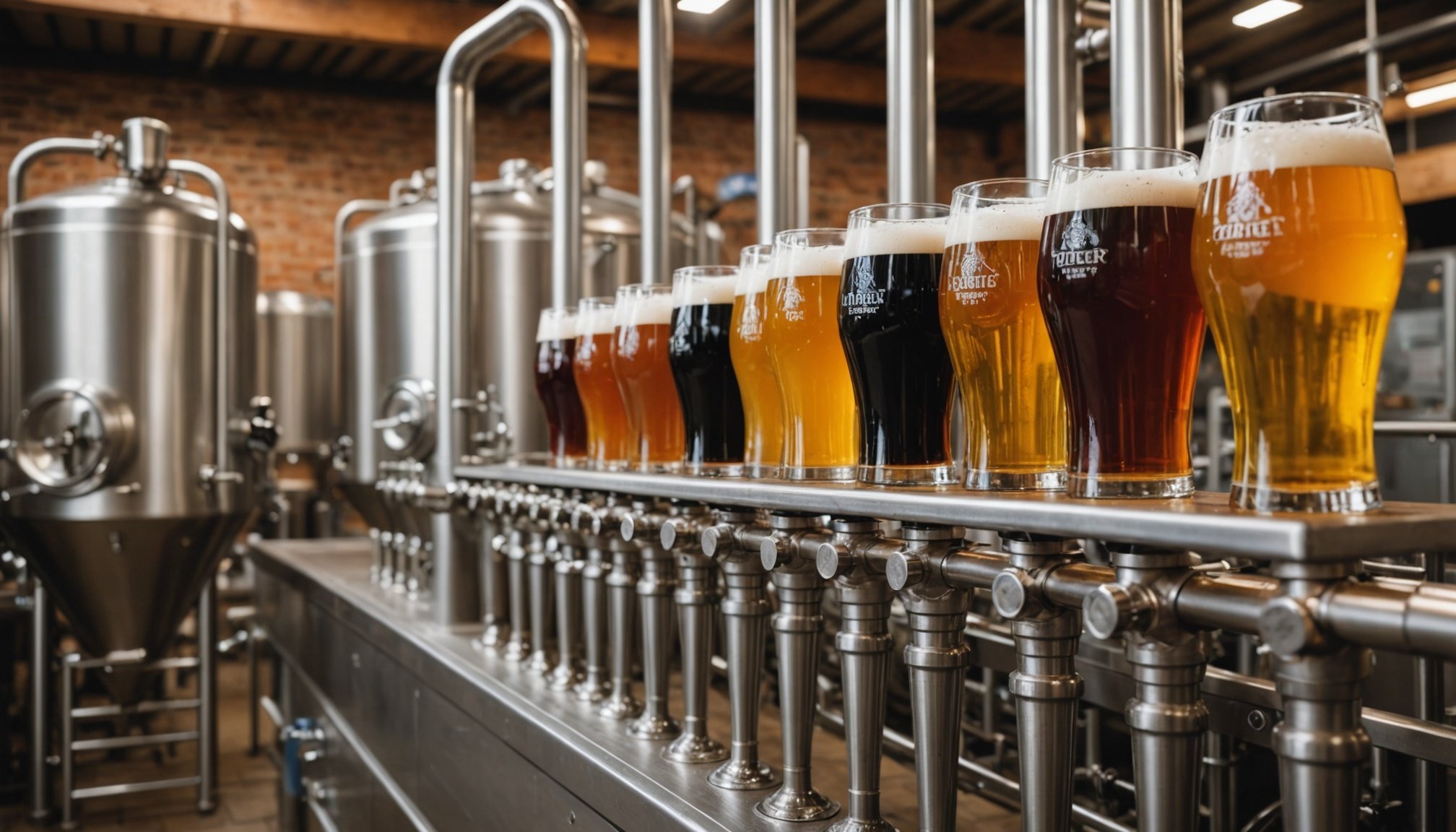The Importance of Data Analytics in Brewing Efficiency
In today’s competitive brewing industry, Data Analytics has emerged as a crucial tool for enhancing Brewery Efficiency. By analysing large volumes of data, breweries can optimise operations, reduce waste, and improve product quality. This involves using analytical tools to track everything from raw material usage to production timelines, providing a clearer picture of where efficiencies can be gained.
Relevance to the Brewing Industry
Data Analytics helps breweries closely monitor production metrics, creating insights that lead to Operational Optimization. For instance, it allows the prediction of equipment maintenance needs, avoiding unexpected downtimes that disrupt production and lead to financial losses. Moreover, by understanding consumption patterns, breweries can better align production schedules with demand, reducing overproduction and underutilisation.
Also read : Essential industrial racking solutions for every business need
Addressing Industry Challenges
The brewing industry faces challenges like fluctuating ingredient costs and varying consumer preferences. Data Analytics provides the capability to swiftly adapt to these changes by offering real-time data insights. It also assists in maintaining consistent product standards, ensuring customer satisfaction and brand loyalty. Through predictive modelling, brewers can simulate different scenarios, preparing them to tackle potential disruptions effectively. Embracing Data Analytics is no longer optional but essential for any brewery aiming for long-term operational success.
Tools and Technologies for Data-Driven Brewery Operations
Breweries are increasingly turning to data tools and brewing technologies to enhance their operations. These technologies offer valuable insights and streamline processes through analytics software.
Also to read : Boosting Student Success: Cutting-Edge Approaches for UK Schools to Elevate Digital Literacy
Overview of Popular Analytics Tools
In the brewing industry, several analytics tools are gaining traction. Platforms like Beer30 and Quantiperm are specifically tailored for breweries. They enable efficient tracking of production metrics and provide actionable insights by analysing data. These tools are invaluable for monitoring key performance indicators (KPIs) and improving overall performance.
Integration of IoT in Breweries
The integration of the Internet of Things (IoT) devices in breweries is reshaping data collection and analysis. IoT sensors monitor various parameters such as temperature, pH levels, and fermentation progress in real-time, providing crucial data that enhances operational efficiency. This technology allows brewers to make informed decisions and maintain consistent quality in their products.
Choosing the Right Data Analytics Software
Selecting the appropriate data analytics software is crucial for breweries aiming for data-driven success. Key factors to consider include compatibility with existing systems, ease of use, and the specific needs of the brewery. It’s essential to evaluate the software’s ability to integrate IoT data and its scalability to ensure future growth. Choosing the right solution can lead to enhanced productivity, reduced costs, and superior brew quality.
Case Studies: Successful Implementation of Data Analytics
In the bustling landscape of UK breweries, data analytics has proven to be a pivotal tool for driving success. This section delves into case studies where breweries have effectively employed analytics to transform their operations and strategies.
One shining example is a UK brewery that embraced analytics solutions to refine its production processes. By analysing data on ingredient usage and fermentation times, the brewery achieved a significant reduction in waste—streamlining operations while maintaining quality.
Key Metrics and Outcomes
The brewery tracked several key metrics to gauge the success of its analytics implementation:
- Waste reduction by 30%
- Cost savings upwards of 20%
- Increased production efficiency without compromising the product quality
Lessons Learned and Best Practices
These case studies underscore the importance of defining clear objectives and maintaining flexibility. Emphasising continuous learning and adaptation allowed breweries to leverage insights gleaned from analytics. They stressed the necessity of integrating analytics into existing systems rather than treating it as an add-on. Additionally, fostering a data-centric culture facilitated employee engagement and innovation.
Strategies for Integrating Data Analytics into Brewery Workflows
In the evolving world of brewing, harnessing data adoption can transform how we work. For optimum integration strategies within a brewery workflow, it is imperative to weave analytics into the fabric of daily operations.
Developing a Data-Driven Culture
Cultivating a culture that champions data-driven decisions is essential. Begin by promoting transparency and collaboration in decision-making processes, where staff use data to boost operations and product quality. This involves everyone, from brewers to marketers, engaging with insightful analytics.
Training Staff for Data Utilization
Effective data utilization hinges on knowledgeable staff. It’s vital to offer training and workshops focused on analytics tools unique to the brewing industry. By empowering employees with these skills, you’re enhancing their capabilities and ensuring a fluent integration of analytics into the brewery workflow.
Creating Actionable Insights from Data
The ultimate goal is adapting data into actionable insights. This means converting raw data into strategic improvements and operational enhancements. As breweries seek efficiency, analytics can provide precise solutions, leading to informed decisions that support growth, quality, and sustainability. These insights help identify trends, forecast demand, and optimize production processes.
Measuring ROI and Performance Indicators
Understanding ROI measurement and identifying relevant performance indicators is crucial for breweries aiming to enhance their analytics success. By focusing on key performance indicators (KPIs), breweries can gain insights into which data-driven initiatives are yielding the best results.
Key performance indicators might include metrics like production efficiency, wastage reduction, or increased sales volume. These indicators help in evaluating how effectively new technologies or strategies are working. An effective approach can lead to noticeable performance improvements, such as reducing operational costs or minimising ingredient wastage.
To accurately calculate ROI from data-driven initiatives, breweries should consider a methodology that accounts for both tangible and intangible benefits. This could involve quantifying cost savings, increased sales, and improved customer satisfaction levels. By comparing the costs of initiative implementation against these benefits, a clear picture of ROI emerges.
Examples of performance improvements post-implementation include:
- Streamlined processes, which reduce delays and improve bottling times,
- Enhanced quality control, leading to fewer product returns,
- Energy savings, through optimised fermentation processes.
By tracking these improvements through KPIs and operational metrics, breweries can ensure that their investments deliver tangible business value over time. This process fosters continued innovation and efficiency gains across the operation.
Challenges in Implementing Data Analytics in Breweries
Breweries, like many industries, encounter several implementation barriers when introducing data analytics. The most prevalent challenges include inadequate infrastructure, resistance to change, and skill shortages. Many breweries grapple with outdated technology and lack the necessary systems to support advanced analytics. This technological gap can hinder effective data collection and processing, making the adoption of data analytics a formidable task.
Common Obstacles Breweries Face
A significant challenge is the integration of data analytics into existing operations. Breweries often encounter data limitations, such as fragmented or incomplete data, which can skew analysis results. In addition, there is frequently an organisational culture that resists change, preferring traditional methods over new technologies. This mindset can obstruct the seamless adoption of data-centric strategies.
Solutions for Overcoming Implementation Challenges
To address these implementation barriers, breweries can invest in modernising their technological infrastructure, ensuring they have robust systems in place. Providing comprehensive training programs can also bridge the skill gap, empowering staff to harness data analytics effectively. Furthermore, fostering a culture open to innovation can encourage acceptance and efficient use of analytics.
The Importance of Data Quality
Maintaining high data quality is crucial for obtaining reliable analysis. Inconsistent or poor-quality data can lead to misleading insights, while accurate data supports informed decision-making. It is essential for breweries to establish rigorous data collection and validation processes to ensure reliable analytics outcomes.
Future Trends in Data Analytics for the Brewing Industry
In the brewing industry, data evolution is significantly influenced by emerging technologies. One trend shaping the future is the integration of machine learning and artificial intelligence into data analytics. These innovations enable breweries to predict consumer preferences accurately, leading to more tailored product offerings. As technology continues to evolve, we’re seeing the adoption of blockchain for supply chain transparency, further ensuring quality and authenticity.
Over the next decade, brewery operations are expected to see a shift towards smart factories. Automation, powered by advanced data analytics, will help breweries optimize production processes and reduce waste. Predictive maintenance, using IoT sensors, will become a standard, reducing downtime and prolonging equipment life.
With consumers becoming more conscious of ingredients and production methods, their preferences are continuously evolving. Breweries are leveraging data analytics to adapt to these shifts swiftly. Social media and sentiment analysis are essential in understanding trends, allowing businesses to align their strategies with current demands efficiently.
In summary, the future trends in data analytics for brewing industries involve embracing technological advancements and adapting to changing consumer pressures. These innovations promise enhanced efficiency, greater customization of products, and a more sustainable approach to brewing.











